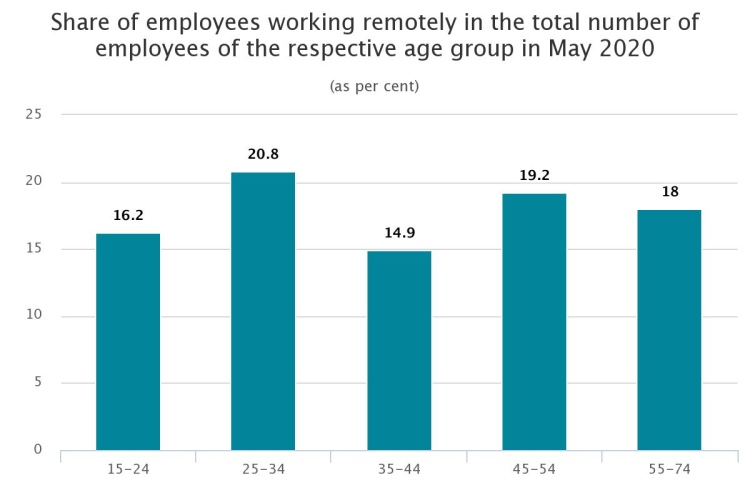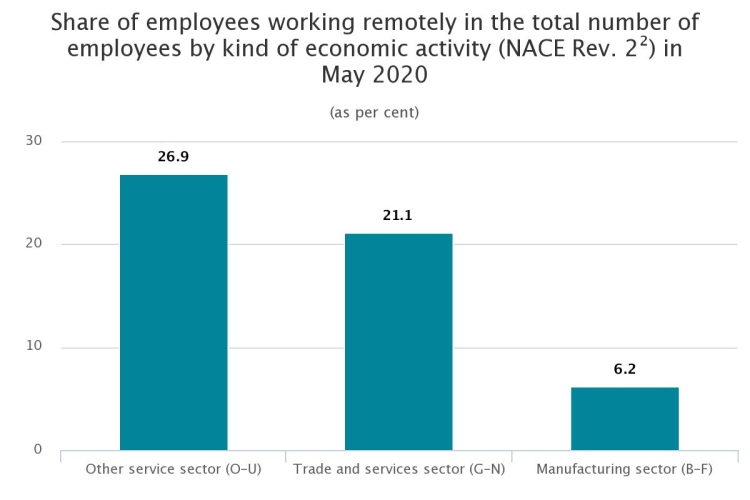Analytics, Covid-19, Employment, Latvia, Markets and Companies, Technology
International Internet Magazine. Baltic States news & analytics
Wednesday, 24.04.2024, 12:52
In May, 18.2% employees in Latvia worked remotely
 Print version
Print versionIn May, 23.9 % of employees had option to work remotely, but slightly more than three fourths (76.1 %) did not have this option. Only 5.8 % of employees having option to work remotely did not use it.

The largest share of persons working remotely were in age groups 25–34 years (26.3 %) and 45–54 years (26.1 %). The largest share of males working remotely (32.5 %) were aged 25–34 years, but females (34.2 %) – in age group 45-54 years.
In May 2020 the largest share of employees working remotely (20.8 %) in the total number of employees of the respective age group was observed in age group 25–34 years, but the smallest (14.9 %) in age group 35–44 years.
In May 2020 almost a half (47.0 %) of all employees working remotely were employed in trade and services sector (G–N)². Slightly less (43.5 %) of employees worked in other service sector (O–U). Only 8.4 % of all employees working remotely were employed in manufacturing (B–F).
Still, the largest (26.9 %) share of employees working remotely in the total number of employees of the respective kind of economic activity sector was observed in other service sector (O–U). Slightly more than one fifth (21.1 %) of employees engaged in trade and services sector (G–N) worked remotely. In manufacturing sector (B–F) only 6.2 % of employees worked remotely.

Most often (51.7 %) professionals³, two fifths (40.7 %) of managers and slightly more than one fourth (28.6 %) of technicians and associate professionals worked remotely. Only every eleventh (9.3 %) clerical support worker (office worker) or service and sales worker worked remotely.
Half (50.6 %) of employees working remotely, worked this way all working time in May, one fifth (20.5 %) – on a regular basis 3–5 days a week, 17.4 % – on a regular basis 1–2 days a week, and 6.8 % of employees – on a regular basis part of the working day or several hours.
In May 2020, 1.1 thousand of population aged 15–74 years in 787 households were surveyed in Labour Force Survey.
The latest data with statistical indicators of economic activity (employment and unemployment) on the 1st quarter of 2020 are available in the CSB database section “Employment and unemployment”.
¹ Remote work – the way work is carried out when employed might do it within the enterprise, but carries it out independently or on a regular basis outside the employer's enterprise using information and communication technologies.
² NACE: Statistical classification of economic activities in the European Community Rev. 2
³ Classification of Occupations
- 28.01.2022 BONO aims at a billion!
- 26.08.2021 LLC Dizozols Investments finalizes investment attraction deal with Crowdestor with record-high profits
- 25.01.2021 Как банкиры 90-х делили «золотую милю» в Юрмале
- 30.12.2020 Накануне 25-летия Балтийский курс/The Baltic Course уходит с рынка деловых СМИ
- 30.12.2020 On the verge of its 25th anniversary, The Baltic Course leaves business media market
- 30.12.2020 Business Education Plus предлагает анонсы бизнес-обучений в январе-феврале 2021 года
- 30.12.2020 Hotels showing strong interest in providing self-isolation service
- 30.12.2020 EU to buy additional 100 mln doses of coronavirus vaccine
- 30.12.2020 ЕС закупит 100 млн. дополнительных доз вакцины Biontech и Pfizer
- 29.12.2020 В Rietumu и в этот раз создали особые праздничные открытки и календари 2021








 «The Baltic Course» Is Sold and Stays in Business!
«The Baltic Course» Is Sold and Stays in Business!

